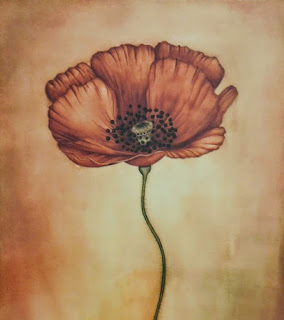Ms. Marino is known for many things: illustrator, storybook writer, designer, as well as an artist. While she has many talents, it is her flower portraits that give me pause, they are soft, sophisticated, realistic and tenderly executed. Many of her flower portraits remind me of the famous floral artist of the 1970s, now deceased, Lowell Blair Nesbitt, whom accomplished over-sized singular flower(s) on canvas and in screen prints.
Nesbitt's flowers were widely collected and are included in numerous museum collections. He was frequently described and grouped with the photo realists. Unlike Nesbitt, Marino works with gouache that she frequently washes out to almost watercolor consistency. Yet, the both of them claim that they are not interested in capturing the botanical/scientific details of a flower.
Nesbitt's flowers captured the entire canvas and he used a flat colored background. Likewise, Marino's flowers capture the entire space of her artworks, the difference is that Marino builds up a colored background that gives more intensity to her flowers. On that background she captures the petals, stem, and leaves. While claiming that she in not interested in the scientific elements of flowers, she illustrates the sexual parts with detail: the carpels (pistil), stamens, and stigma. Remember the stigma top is sticky and receives the pollen during fertilization. All that is missing is the insects that assist with the fertilization process.
Below Marino's "Hollyhock" 2003, is painted with a single blossom and stem. The petals have a gadrooned rim that moves from dark maroon to almost black. The singular leaf takes on a dotted pattern and in nature is made up of silicon, phosphorus, chlorine, sulphur, potassium and calcium. While we frequently think of hollyhocks as a tall Eurasia plant with a long cluster of large showy flowers, Marino breaks down the details for us to see just one blossom.
In the second watercolor, "Poppy" also from 2003, the petals have a variation in color and each petal has a decorative rim. While it is not totally visual in the photo below, the stem is hairy along the stock. The black dots in the center of the flower represents the rounded seed capsules.
Nesbitt's flowers were widely collected and are included in numerous museum collections. He was frequently described and grouped with the photo realists. Unlike Nesbitt, Marino works with gouache that she frequently washes out to almost watercolor consistency. Yet, the both of them claim that they are not interested in capturing the botanical/scientific details of a flower.
Nesbitt's flowers captured the entire canvas and he used a flat colored background. Likewise, Marino's flowers capture the entire space of her artworks, the difference is that Marino builds up a colored background that gives more intensity to her flowers. On that background she captures the petals, stem, and leaves. While claiming that she in not interested in the scientific elements of flowers, she illustrates the sexual parts with detail: the carpels (pistil), stamens, and stigma. Remember the stigma top is sticky and receives the pollen during fertilization. All that is missing is the insects that assist with the fertilization process.
Below Marino's "Hollyhock" 2003, is painted with a single blossom and stem. The petals have a gadrooned rim that moves from dark maroon to almost black. The singular leaf takes on a dotted pattern and in nature is made up of silicon, phosphorus, chlorine, sulphur, potassium and calcium. While we frequently think of hollyhocks as a tall Eurasia plant with a long cluster of large showy flowers, Marino breaks down the details for us to see just one blossom.
 |
| Hollyhock, 2003 Watercolor on Japanese Mulberry Paper Approximately 7.5 " x 10.5" Signed on Mat: Gianna Marino |

Comments
Post a Comment